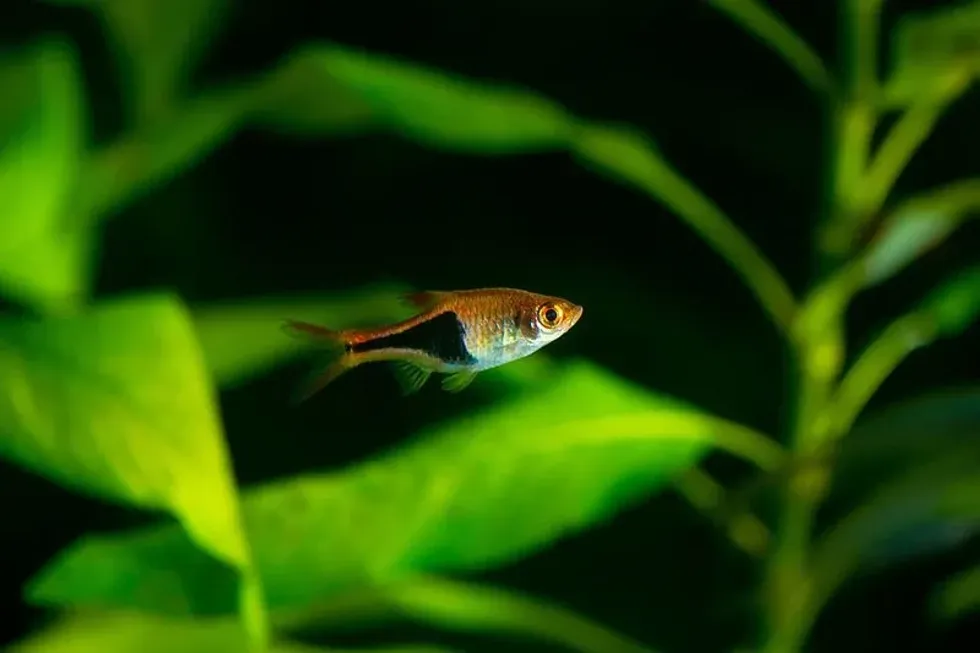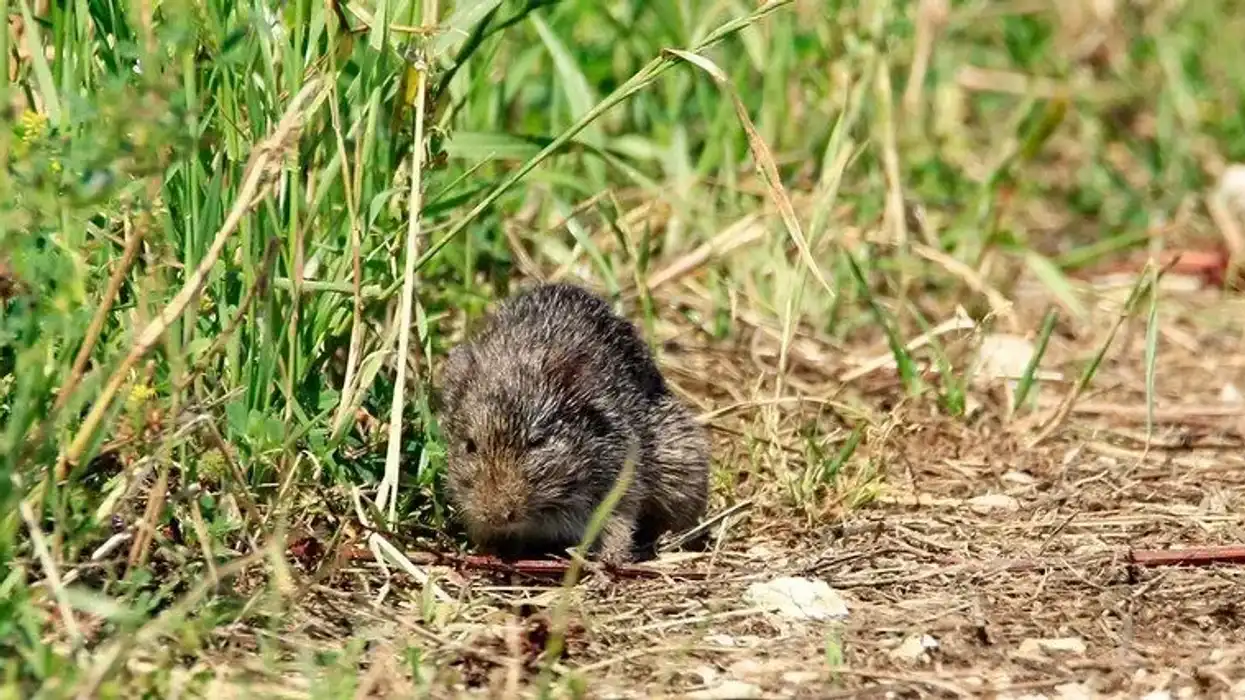The harlequin rasbora (Trigonostigma heteromorpha) is a tiny fish that belongs to the community of Cyprinidae.
The name harlequin rasbora has been derived from heteromorpha (Greek 'differently shaped') owing to the fact that its body shape differed from other members of that species.
The harlequin rasboras are native of Malaysia, Singapore, Sumatra, and southern Thailand. Harlequin rasboras dwell in streams and other watercourses predominantly having low mineral content and high concentrations of dissolved humic acids.
The harlequin rasbora is more or less having a lozenge-shaped body, these fishes are largely found in orange-pink color from the head to the caudal peduncle however the exact color varies depending upon factors as water conditions and the original population from which the fish was obtained
The harlequin rasbora is a shoaling fish; it is recommended that they be kept in groups of eight to 10 individuals while larger numbers make for a beautiful display as well. Harlequin rasboras can be kept with any fish provided that it's not large and predatory.
Harlequin rasboras fish will not squabble underwater with any other species or with its tank mates. Harlequin rasboras have a preference to eat live foods whenever possible however, they feed all foods.
The fish prefers Brine shrimp, mosquito, and any type of worm are excellent supplemental foods.
Spawning of these fish happens throughout the year, and females lay eggs under the leaves of water plants. Also, the female is larger in size than the male.
For more relatable content, check out these channel catfish facts and rockfish facts for kids.
Rasbora Interesting Facts
What type of animal is a rasbora?
The harlequin rasbora (Trigonostigma heteromorpha) is a small fish in the family Cyprinidae. It is the best known and most commonly kept species among the rasboras. These fishes are very peaceful.
What class of animal does a rasbora belong to?
The rasbora is a tropical fish species that belongs to the class Actinopterygii, from the phylum Chordata.
How many rasboras are there in the world?
The total population size of rasbora is unknown. They have a large distribution across the world, and their population is stable.
Where does a rasbora live?
Rasbora, (genus Rasbora), is a group of about 45 species schooling under freshwater tropical fish belonging to the Cyprinidae family. The majority of the species are found in Southeast Asia, but a few are inhabitants of Africa.
What is a rasbora's habitat?
This aquarium fish inhabits in freshwater habitats of Malaysia, Thailand, and Singapore. It originates in peat swamps and forest pools and streams with lots of cover and plant matter. They can survive in the relatively uniform water chemistry of various habitats.
Who do rasboras live with?
Harlequin rasboras are tank fish, who are friendly and get along with most similarly sized species. Depending on the species, they can be kept with other rasboras. Harlequin rasboras find cardinal tetras, bettas, neon tetras, small barbs, dwarf gouramis, danios, other small rasboras to be good tank mates.
How long does a rasbora live?
The life span of the harlequin rasbora has not been scientifically determined, but individuals in the aquarium can be expected to live for five to eight years if they are nurtured with good care like mosquito larvae make brilliant conditioning food for this species. It usually resides in temperatures varying from 73-82 F (23-28 C).
How do they reproduce?
Spawning generally takes place under plant cover; eggs stick to the undersides of large leaves. Harlequin rasbora breeding occurs throughout the year.
In the process, the female harlequin rasbora will swim in an upturned position under a preferred leaf, rub her belly along the leaf in preparation for spawning, this basically encourages the males to join.
Once the male join, they similarly stay in an inverted position alongside the female, and the female extrudes her eggs and attaches them to the underside of the leaf.
During the course, 6-12 eggs at a time are dropped with each such embrace; in the entire event, the female may deposit as many as 300 eggs if the temperature is preferable, although 80-100 is a more usual number. It has been found that the female harlequin rasboras are often larger and rounder than the males.
Fertile harlequin rasbora eggs necessitate roughly 18 hours to hatch at a temperature of 28 °C. Upon hatching, the harlequin rasbora fry is translucent, around 0.11-o.15 in (3-4 mm) long, and lingers on the leaf upon which the eggs were laid for a further 12-24 hours, during which the yolk sac is immersed.
Once this procedure is concluded, the fish become free-swimming underwater.
What is their conservation status?
The conservation status of harlequin rasboras is of Least Concern (IUCN).
Rasbora Fun Facts
What do rasboras look like?

The appearance of the harlequin rasbora consists of a dark triangular patch extending all the way back from the front of the caudal fin, which is very distinguishing. The silvery tone of the rest of the body may be broken with yellow or reddish markings and is responsible for its nickname as a red razor.
The basal color from the head to the caudal peduncle is orange-pink. They are ideal for tank or aquarium fish, with the appropriate gallon of water and temperature.
How cute are they?
Harlequin rasboras look lovable and are known for their distinguished appearance.
How do they communicate?
The mode of communication among harlequin rasboras is still unknown.
How big is a rasbora?
Most rasbora fish grow to less than 4 in (10.1 cm), which makes them perfect for small to mid-sized aquariums. Popular species like purple rasboras, emerald dwarf rasboras, green rasboras, zebra rasboras, neon blue rasbora, mosquito rasbora, neon rasbora, porkchop rasbora typically do not get larger than 2 in (5 cm). They are similar or even smaller than anchovies.
How fast can a rasbora swim?
Rasboras are mid-level swimming fish and they are considered to be great schooling fish. They stay comparatively small, non-violent, and are easy to keep.
How much does a rasbora weigh?
Considering the tiny size of harlequin rasboras, the weight is unknown.
What are the male and female names of the species?
The males and females rasbora are not known by any distinguished names but the tropical fishes can be differentiated due to their appearances.
What would you call a baby rasbora?
The young of rasbora harlequin is generally known as fry.
What do they eat?
Rasboras are not scrupulous about their eating habits and enjoy a wide variety of high-quality flakes or granules and live food such as mosquito, daphnia, and artemia, brine shrimp. Rasboras also enjoy regular treats of fresh vegetables and simple foods.
Are they dangerous?
Rasboras (tropical fish) are not at all dangerous, rather they are very peaceful. These are considered to be schooling fish and possess a very friendly nature. Harlequin rasboras prefer to live in a group/community tank. It is a perfect choice for home aquariums.
Would they make a good pet?
Harlequin rasbora species are a great example of an unproblematic shoaling fish to add to your tank. . This charming small fish has very few explicit care needs and they aren't very challenging.
Harlequin rasbora care is very easy, and as long as they're fed a simple diet, and their tank is kept clean, they'll prosper. They may be fed with plants as well.
Also, add plants in the tank so that when breeding season occurs, they can lay eggs on them. They just need 10 gallons of water for breeding. Harlequin rasbora's tank mates can also include dwarf gouramis, danios, rummy nose tetra, neon tetras, cory catfish, cherry barbs, and other small fishes.
Did you know...
The reproduction aquarium for the harlequin rasboras demands the presence of suitable plants Cryptocoryne species is considered as the foremost choice.
The water in the breeding aquarium must be soft and acidic, since the fish are unlikely to produce in hard, alkaline water, and additionally egg fertility emerges to be unfavorable in such conditions even if the parents do spawn.
Why is it called a rasbora?
The name rasbora was introduced considering the specific description of the genus Cyprinus by the British zoologist Francis Buchanan, in the journal 'An Account of the Fishes Found in the River Ganges and its Branches'.
What is unique about a rasbora?
Rasbora has a very unique trait that it shimmers in the light, which gives it a cosmic look and it is very well known for it. The fins acquire bright red color with some unique contrast. These fish spend most of their time at the bottom of the water column. There are presently over 100 species of rasboras.
Here at Kidadl, we have carefully created lots of interesting family-friendly animal facts for everyone to discover! Learn more about some other fish from our bonito fish facts and koi facts pages.
You can even occupy yourself at home by coloring in one of our free printable rasbora coloring pages.









